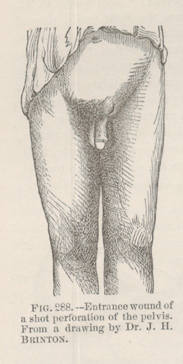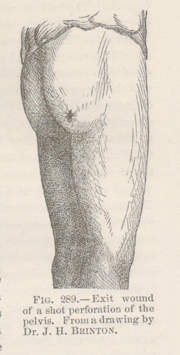Title: Rumrill, G. C.
Source text: The Medical and Surgical History of the War of the Rebellion. (1861-65.), Part 2, Volume 2 (Washington, DC: Government Printing Office, 1876), 366.
Civil War Washington ID: med.d2e31804
TEI/XML: med.d2e31804.xml
CASE 1064.—Private G. C. Rumrill, Co. E, 1st Vermont Cavelry, aged 18 years, was wounded in a skirmish at Waterloo Bridge, on the Rappahannock, August 29, 1862. He was sent to Washington, and admitted to Armory Square Hospital. The Regimental and hospital records simply chronicle the injury as vulnus sclopeticum, Surgeon D. W. Bliss reporting that the man was discharged for this cause, November 19, 1862. Surgeon J. H. Brinton's note-book, however, and the report of the pension examiners furnish some particulars of the nature and progress of the case. "The ball entered," according to the report of February 21, 1863, of the Pension Examiners Drs. R. Clark and L. A. Richmond, of Hartland, Vermont, "just above the pubes, a little to the right of the symphysis and emerged at the right side of the coccyx, near the tuberosity of the ischium, passing through the bladder and the intestine near the coccyx. At present he has urinary fistula, with total inability to stand or walk. His disability is total, probably for life." Surgeon J. H. Brinton, U. S. V., who examined the patient at Armory Square Hospital and made drawings of the seat of the wounds (FIG. 288, 289), reported that "the day after the reception of the injury urine escaped from the orifices of the wounds of entrance and exit. After two weeks, the entrance wound (FIG. 288) healed, but urine continued to flow from the exit wound (FIG. 289). At this date, September 14th, the patient slept badly, his bowels were constipated, the pulse at 140, feeble and irregular; little or no pain on pressure over the abdomen. There were two urethral fistulas, one underneath the root of the penis and the scrotal junction, and one in the perineum. The ball probably divided in its course the membranous or prostatic portion of the urethra, or the neck of the bladder. For a month subsequently, all the urine was discharged through the orifice through which the ball emerged. This orifice gradually contracted, and, six weeks after the injury, only a third or fourth part of the urine escaped by it, the remainder being passed by the meatus." Leaving the hospital, November 19, 1862, the patient went to his home at Hartland, Windsor County, Vermont, and no further information has been received respecting him except the report already given of the pension examiners, and an announcement of his death, September 28, 1863.

